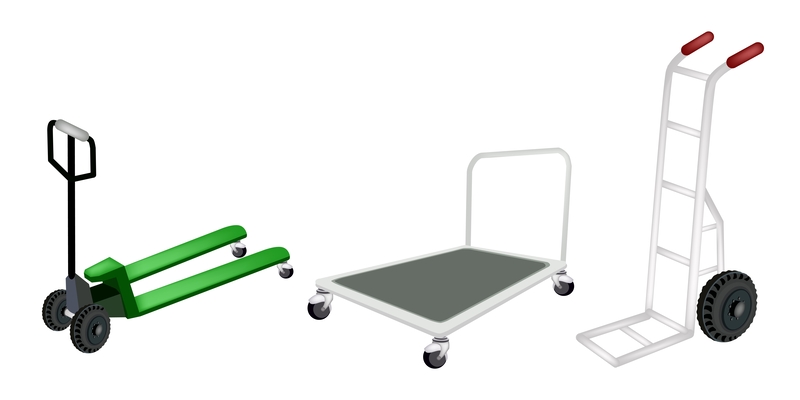The Science Behind Kinetic Lifting and How It Works
Kinetic lifting is more than just a buzzword in the world of strength training and ergonomics; it is a revolutionary approach to lifting objects that leverages the principles of physics and human biomechanics. In today's fast-paced environment where efficiency and injury prevention are paramount, understanding the mechanics of kinetic lifting can make all the difference. This comprehensive article explores the science behind kinetic lifting and how it works, offering valuable insights into its benefits, techniques, and applications.

Understanding Kinetic Lifting: What Sets It Apart?
Kinetic lifting is fundamentally different from traditional lifting techniques. While conventional lifting often relies heavily on muscular strength and brute force, kinetic lifting employs a combination of:
- Momentum
- Leverage
- Natural body mechanics
- Energy transfer
By harnessing the body's kinetic energy--that is, energy generated through motion--kinetic lifting reduces the risk of strain, enhances performance, and increases efficiency in lifting tasks.
The Core Principles of Kinetic Lifting
To truly comprehend kinetic lifting science, it's essential to break down its core principles:
- Using body momentum: Initiating motion with the legs and hips to "drive" the lift, instead of relying mainly on your arms and back.
- Synchronized movement: Coordinating your entire body so multiple muscle groups share the load.
- Maintaining a neutral spine: Keeping your back straight, reducing the risk of injury.
- Center of mass: Keeping objects close to your body to optimize balance and control.
- Efficient energy transfer: Utilizing smooth, deliberate movements to transfer kinetic energy from the ground up.
The kinetic lifting method transforms the way we approach lifting tasks, moving beyond strength alone to focus on movement quality and safety.
The Physics Behind Kinetic Lifting
Kinetic lifting is deeply rooted in the laws of physics. When you analyze how kinetic lifting works, you'll discover that it's primarily an application of Newton's Laws of Motion.
1. Newton's First Law (Law of Inertia)
An object in motion stays in motion unless acted upon by an external force. In the context of kinetic lifting techniques, once you initiate the motion with your legs and hips, your entire body's movement makes the load easier to lift.
2. Newton's Second Law (Force = Mass x Acceleration)
The force you apply to an object depends on its mass and the acceleration you impart. By accelerating the load using the large muscles of your legs and hips, you can generate more force efficiently--reducing the strain placed on smaller, more injury-prone muscles.
3. Newton's Third Law (Action and Reaction)
Every action has an equal and opposite reaction. Pushing against the ground during a lift creates a reactive force that helps propel the object upward.
- Momentum: Momentum is the product of mass and velocity. In kinetic lifting, you use your body's momentum to assist in lifting heavy objects, leveraging both speed and mass for maximum efficiency.
- Leverage: Proper lifting posture creates leverage, making heavier loads feel lighter. The further the object is from your center of gravity, the harder it is to control. Keeping it close maximizes leverage and control.
Biomechanics: How the Human Body Powers Kinetic Lifting
Biomechanics, the study of the mechanical laws relating to the movement of living organisms, is vital in understanding the effectiveness of kinetic energy lifting.
Muscle Groups Involved in Kinetic Lifting
- Quadriceps and hamstrings: Engage to drive the initial movement from the ground up.
- Gluteal muscles: Provide power during hip extension, which is essential for powerful lifting motions.
- Core muscles: Stabilize the spine and enhance overall balance.
- Latissimus dorsi and upper back: Assist in pulling the load close to the body and completing the lift.
By engaging multiple muscle groups in a coordinated fashion, kinetic lifting spreads the effort more evenly across the body, minimizing overload and reducing the risk of injury.
The Kinetic Chain: Connected Movement
One of the hallmarks of kinetic lifting is its reliance on the "kinetic chain." This term refers to how different parts of the body are linked together to perform smooth, coordinated movements:
- Energy is generated from the ground up (feet, legs, hips).
- Transfers through the core and stabilizing muscles.
- Ends at the arms and hands, which grip and control the load.
If any link in this kinetic chain is weak or misaligned, efficiency drops and injury risk increases. Proper technique ensures all body segments are synchronized for maximum lifting performance.
Comparing Kinetic Lifting to Traditional Lifting Methods
Traditional lifting often emphasizes brute strength and superficial muscle use, while dynamic kinetic lifting techniques prioritize movement quality, posture, and efficiency. Here's a comparison:
- Traditional Lifting:
- Heavy reliance on the lower back and arms.
- Static posture and limited movement patterns.
- Higher injury risk, especially in repetitive tasks.
- Kinetic Lifting:
- Active use of legs, hips, and core muscles.
- Dynamic, fluid movement patterns.
- Reduces unnecessary stress on joints and muscles.
- Improved balance, control, and safety.
Understanding these differences highlights why kinetic lifting is increasingly recommended in workplaces, gyms, and daily life.
Key Benefits of Kinetic Lifting
- Injury prevention: By spreading the load across multiple muscle groups and reducing stress on the spine, kinetic lifting lowers the risk of musculoskeletal injuries.
- Efficiency: Harnessing kinetic energy and body mechanics means less effort is required to move the same load.
- Endurance: Reduced muscle fatigue allows for prolonged activity and less soreness after lifting sessions.
- Improved performance: Optimal movement patterns translate to greater lifting capacity and improved athletic outcomes.
- Accessibility: Anyone can learn kinetic lifting techniques, regardless of age or fitness level.
Kinetic Lifting Techniques: Step-by-Step Guide
Ready to incorporate kinetic lifting into your routine? Here's a step-by-step guide for safe and effective kinetic lifts:
1. Assess the Load
- Test the weight and stability of the object.
- Ensure a clear path for movement.
2. Proper Foot Placement
- Stand with feet shoulder-width apart.
- Toes slightly pointed outward for balance.
3. Hip Hinge and Bend the Knees
- Bend at the hips, not the back.
- Keep the spine in a neutral position.
- Lower yourself by bending your knees, keeping your chest lifted.
4. Secure the Grip
- Grip the object firmly with both hands.
- Bring the object close to your body.
5. Initiate the Lift
- Engage the core and keep your back straight.
- Drive through your heels, extending your legs and hips simultaneously.
- Use the upward momentum from your legs and hips to lift the object smoothly.
6. Complete the Movement
- Maintain control as you bring the object to waist or chest height.
- Move in one fluid motion, avoiding jerky or abrupt movements.
- Set down the object using a reverse motion, hinging at the hips and bending the knees.
Kinetic Lifting in Sports and Fitness
Many athletes and fitness professionals swear by kinetic-based lifting techniques for enhancing performance and building functional strength. Examples include:
- Olympic weightlifting: Movements like the snatch and clean & jerk are classic forms of kinetic lifting, combining force, speed, and technique.
- Powerlifting: Squats and deadlifts leverage kinetic energy for maximum load movement.
- Functional fitness: Exercises such as kettlebell swings, medicine ball slams, and plyometrics use kinetic principles to train the whole body in unified movements.
Incorporating kinetic lifting science into your fitness regimen not only improves athletic performance, but also enhances everyday functional abilities--such as lifting groceries, moving furniture, or picking up children.
Kinetic Lifting and Workplace Ergonomics
Many modern workplaces encourage kinetic lifting to prevent common injuries and boost productivity. Proper lifting mechanics are essential for:
- Material handlers
- Healthcare workers
- Construction teams
- Warehouse staff
Employers frequently implement kinetic lifting training to reduce workplace accidents and musculoskeletal injuries--which are leading causes of lost productivity and rising healthcare costs.
Common Mistakes in Kinetic Lifting and How to Avoid Them
Like any physical skill, improper execution of kinetic energy lifting can result in ineffective movements or injuries. Avoid the following common mistakes:
- Rounding the back instead of hinging at the hips.
- Lifting with the arms, rather than driving through the legs and hips.
- Overextending or locking out the knees at the top of the lift.
- Holding the object too far from the body, creating unstable leverage.
- Using jerky, unsynchronized movements rather than a smooth kinetic chain.
Tip: Regular practice, proper instruction, and awareness of body mechanics are crucial for mastering kinetic lifting methods.
How to Train for Kinetic Lifting: Exercises and Tips
Incorporate the following exercises to build strength and coordination for better kinetic lifting:
- Squats and Deadlifts: Develop foundational leg and hip power.
- Kettlebell Swings: Train hip hinging and explosive movement.
- Medicine Ball Throws: Improve upper body coordination and force transfer.
- Planks and Core Work: Strengthen stabilizing muscles for spinal protection.
- Dynamic balance drills: Enhance overall coordination and control.
Pay attention to form and rhythm in every repetition, emulating the fluid, efficient motions of authentic kinetic lifting technique.

The Future of Kinetic Lifting Science
As our understanding of biomechanics and ergonomics advances, the science behind kinetic lifting will continue to evolve. Innovations may include:
- Wearable sensors to analyze lifting patterns and provide real-time feedback.
- Customized lifting aids that enhance energy transfer.
- Robotics and exoskeletons designed to mimic kinetic lifting mechanics.
The future promises even more efficient and safe lifting methods across athletics, healthcare, industry, and beyond.
Conclusion: Why Kinetic Lifting Matters
Understanding the science of kinetic lifting and applying its principles can transform your approach to physical activity, health, and safety. Whether you're an athlete, a worker, or simply looking to improve your daily movement, leveraging kinetic energy for lifting tasks leads to greater efficiency, reduced injury risk, and enhanced overall performance.
By employing kinetic lifting methods, anyone can harness the natural power of their body's movement and momentum. This innovative approach--rooted in physics, biomechanics, and ergonomics--offers a smarter, safer way to lift, move, and thrive.
If you're looking to boost your strength, prevent injuries, and optimize your physical capabilities, start training with kinetic lifting techniques today. The benefits of kinetic lifting are within your reach, one efficient lift at a time.



